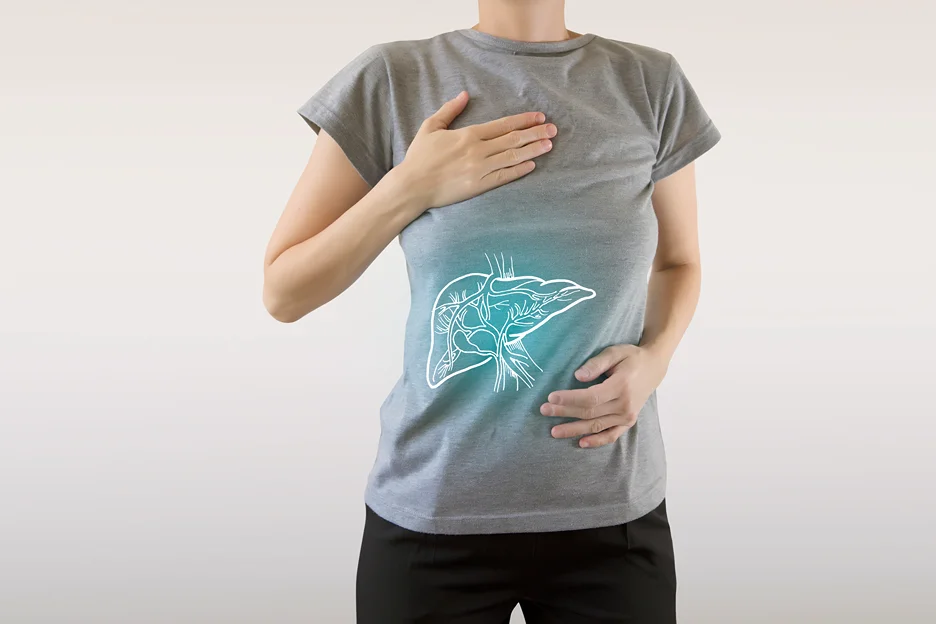Living with a healthy liver is like having a sensational sidekick in your body’s squad of organs. This superstar is vital for detoxifying harmful substances, supporting digestion, and helping your body store essential nutrients.
But did you know, this unsung hero can sometimes be under siege from its own resident cells? Welcome to the world of liver steatosis, a common but often overlooked condition that can sneak up on our livers.
In the simplest terms, steatosis refers to the excessive accumulation of fat in liver cells. This abnormal buildup can eventually lead to inflammation, scarring, and, in some cases, irreversible liver damage. While it might all sound like doom and gloom, our understanding of this condition has benefitted from an unexpected player – an enzyme known as diamine oxidase (DAO).
You might be wondering, what exactly is diamine oxidase and what’s its secret superpower? DAO is an enzyme produced mainly in your kidneys and digestive tract. It plays a crucial role in breaking down histamines (chemicals your body produces during an allergic reaction). But recent research suggests that its role might extend further, all the way to the intricate health of your liver.
Non-Alcoholic Fatty Liver Disease (NAFLD) and Diamine Oxidase: A Tale Of Two Warriors
Picture this: you’re walking down the street and spot a mysterious tag team wrestling match titled ‘NAFLD & DAO vs. Liver Steatosis’. Intriguing, isn’t it?
If you’re a regular Joe (or Jane), you might wonder what NAFLD, an acronym for Non-Alcoholic Fatty Liver Disease, and the enzyme DAO are doing in a tag team together. Are they the heroes or the villains of this match? Let’s pull back the curtains and find out.
NAFLD can occur in people who do not drink alcohol, but it can also occur in people who drink moderately or heavily. If left untreated, NAFLD can progress to more serious liver diseases, such as liver inflammation, cirrhosis, or even liver failure.
The role of diamine oxidase (DAO) in NAFLD is not fully understood. However, recent studies have suggested that low levels of DAO may be associated with NAFLD. This is because DAO helps to break down histamine, a chemical that can damage the intestinal barrier.
When the intestinal barrier is damaged, it allows harmful substances to pass from the gut into the bloodstream, which can contribute to the development of NAFLD.
DAO does more than just break down histamines; it acts as a sort of gatekeeper for your gut, assisting in the maintenance of intestinal barrier integrity. This means ensuring that the ‘bad guys’ – unwanted particles, toxins, and certain bacteria – don’t escape from your gut into the rest of your body, including the liver.
It is possible that lower levels of DAO may be associated with a weaker intestinal barrier, which could allow more harmful substances to pass from the gut into the bloodstream and potentially cause inflammation in the liver. However, more research is needed to confirm this link.
With liver steatosis and its potential heavyweight consequences looming large, understanding the dynamic duo of NAFLD and DAO can mean the difference between a championship win or a disappointing defeat for your liver health.
Guarding the Fort: Diamine Oxidase and Intestinal Barrier Function
Now that we have discussed the role of DAO in NAFLD, let’s turn to another important function of DAO: its role in maintaining the integrity of the intestinal barrier.
The intestinal barrier is a thin layer of cells that lines the inside of the gut. It acts as a gatekeeper, allowing nutrients to pass through while keeping harmful substances out.
Nestled at the heart of this narrative is DAO, an enzyme that helps to break down histamine and maintain the integrity of the intestinal barrier. Quite the multitasker, isn’t it?
Now, how do these dots connect to paint a picture of liver health? A weakened intestinal barrier can allow harmful substances and bacteria to pass through, which can trigger inflammatory reactions in the liver. This can lead to metabolic abnormalities and chronic liver diseases such as NAFLD and steatohepatitis.
Remember those tag-teams from before? DAO levels are thought to play a role in maintaining the integrity of the intestinal barrier. Lower levels of DAO may be associated with a weaker barrier, which could allow more harmful substances to pass through and potentially cause inflammation in the liver.
This suggests that DAO may play an important role in preventing liver damage. However, more research is needed to confirm this link.
How Diamine Oxidase Tames Inflammation and Battles Oxidative Damage in Liver Cells

DAO is also thought to play a role in taming inflammation and battling oxidative damage in liver cells.
So, why should someone outside the medical world care about inflammation and oxidative damage? Here’s why: Inflammation and oxidative damage are two factors that can contribute to liver damage.
Inflammation can damage liver cells and lead to liver steatosis, which is the buildup of fat in the liver. NASH is a more serious form of liver damage that can lead.
On the other hand, oxidative damage, an imbalance in the body’s ability to counteract harmful effects of free radicals, can also storm your liver like a siege, causing a cascade of harmful effects that can lead to conditions like hepatic steatosis.
Now, let’s bring back DAO into the spotlight. Reduced levels of DAO in colon tissues may be associated with a weakened intestinal barrier function. This could allow harmful bacteria and toxins to pass through the intestinal barrier and enter the liver.
This could lead to inflammation and oxidative damage in the liver, which could contribute to the development of NAFLD, NASH, and liver fibrosis.
In the face of such threats, DAO may help to maintain the integrity of the intestinal barrier and prevent harmful bacteria and toxins from passing through. This could help to reduce inflammation and oxidative damage in the liver.
Decoding the Diet Code: How Your Diet Influences Your Liver Health
You’ve heard it before – “You are what you eat”. But have you ever stopped to think about the profound impact your diet has on your liver health? It is well-known that diet can have a significant impact on liver health. A high-fat diet is a major risk factor for NAFLD, and it can also worsen the condition in people who already have it.
NAFLD is a condition in which fat builds up in the liver. It is the most common liver disease in the world, and it is often associated with a high-fat diet.
High-fat diets can cause inflammation, insulin resistance, and other metabolic abnormalities. These can lead to liver steatosis, which is the buildup of fat in the liver. NASH is a more serious form of liver damage that can lead to liver fibrosis and cirrhosis.
A high-fat diet can damage the intestinal barrier, which can allow harmful bacteria and toxins to pass through. This can lead to inflammation and oxidative damage in the body.
Once again, our hero DAO steps into the fray. DAO helps to break down histamine, a chemical that can damage the intestinal barrier. Reduced levels of DAO may make the intestinal barrier more vulnerable to damage from harmful bacteria and toxins.
Leveling the playing field are our unfathomable gut bacteria that can contribute to, or protect against, liver disease, depending from which angle you look. A high-fat diet can cause non-beneficial bacteria to bloom, while diminishing our friendly counterparts, leading to a state of ‘dysbiosis‘.
This imbalance can supercharge inflammatory reactions, further compromising intestinal barrier function and exacerbating the development of liver diseases.
Turning the Tide: Promoting Liver Health Amidst Challenging Tides
We’re all aboard the same ship when it comes to wanting a healthy body. Whether you’re grappling with metabolic disorders, battling liver steatosis, or just keen on preventing any liver-related illnesses, promoting liver health should be top of your watchlist.
Taking control over liver health might feel like steering a ship through a tumultuous storm. But don’t worry, you don’t have to walk the plank just yet. There’s a treasure trove of therapeutic targets we can tap into to help insulate your liver against the perils of our modern lifestyles.
As our journey has shown us, As we have discussed, DAO plays an important role in maintaining the integrity of the intestinal barrier. However, there are other factors that can also affect liver health, such as a high-fat diet, bacterial overgrowth, and inflammation.
Metabolic abnormalities, such as obesity and diabetes, are common in our society and can damage the liver. These conditions can lead to the buildup of fat in the liver, inflammation, and cell damage.
In the face of these challenges, the paradigm slowly starts to shift towards reinforcing our intestinal barrier, nurturing a flourishing gut microbiome, and mitigating oxidative damage. Approaches such as introducing prebiotics or probiotics, and even exercising Metabolic Surgery can help regulate the gut flora and strengthen intestinal integrity further, thereby keeping liver disease at bay.
Special Conditions: Liver of Pregnancy and Metabolic-Associated Fatty Liver Disease (MAFLD)
Two conditions that can affect liver health are liver of pregnancy and metabolic-associated fatty liver disease (MAFLD). DAO has been linked to both of these conditions, but the exact role of DAO is still being studied.
Liver of Pregnancy – A Temporary Visitor?
Liver of pregnancy is a temporary liver disorder that can occur during pregnancy. It is usually not serious and goes away after the baby is born.
Symptoms can include:
- Nausea
- Poor appetite
- Fatigue or lethargy
- Jaundice
Interestingly, during pregnancy, DAO levels can significantly rise, possibly as the body’s response to mitigate any potential increase in the permeability of the intestinal barrier. However, much is still unknown about why this phenomenon occurs and the implications for liver health.
Metabolic-Associated Fatty Liver Disease (MAFLD) – A Rising Challenge
MAFLD is a progressive liver disease that is caused by metabolic disorders. It can lead to serious complications, such as NASH, liver fibrosis, and liver cancer.
MAFLD is characterized by:
- An excessive accumulation of fat in the liver
- A strong correlation with type II diabetes and obesity
- An increased risk of heart disease and other metabolic syndromes
The role of DAO in MAFLD is still being studied, but it is possible that DAO plays a role in protecting the liver from damage.
| Condition | DAO levels | Implications |
| Liver of Pregnancy | Increased | Possible mitigation of increased intestinal permeability |
| MAFLD | Under Investigation | Potential for therapeutic targets |
Conclusion: The Enlightened Path to Liver Health

As we close the curtains on our Liver Health Saga, it’s important to step back and appreciate the bigger picture – an array of intertwined factors playing in harmony like a symphony that collectively directs the course of our liver health.
We’ve seen firsthand how the unsung hero, Diamine Oxidase (DAO), steps up to the plate, maintaining the integrity of the intestinal barrier, and setting off a domino effect on our bodies’ overall wellbeing – the front liners against chronic liver diseases.
Here are some highlights which can act as a mini-guide to promote liver health:
- Embrace a balanced diet.
- Manage metabolic disorders like diabetes, obesity, and metabolic syndromes.
- Foster a flourishing gut microbiome.
- Opt for prebiotics or probiotics to regulate gut flora.
- Regularly monitor DAO levels for intestinal barrier function.
Remember, the fight against liver diseases like liver steatosis, NAFLD, MAFLD, and the host of other liver conditions is a continuous battle. It’s a conquest that starts with enlightening ourselves about the intricacies of our body’s functions and how everything connects.
